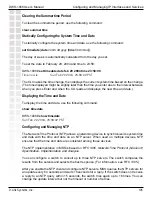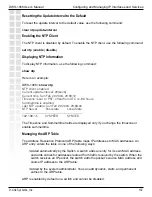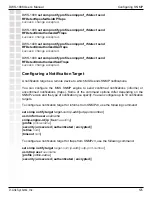
115
DWS-1008 User’s Manual
D-Link Systems, Inc.
Configuring SNMP
Configuring SNMP
Overview
The MSS SNMP engine (also called the SNMP server or agent) can run any
combination of the following SNMP versions:
• SNMPv1 - SNMPv1 is the simplest and least secure SNMP version.
Community strings are used for authentication. Communications are in the
clear (not encrypted). Notifications are traps, which are not acknowledged by
the notification target (also called a trap receiver).
• SNMPv2c - SNMPv2 is similar to SNMPv1, but supports informs. An inform
is a notification that is acknowledged by the notification target.
• SNMPv3 - SNMPv3 adds authentication and encryption options. Instead of
community strings, SNMPv3 supports user security model (USM) users, with
individually configurable access levels, authentication options, and
encryption options.
All SNMP versions are disabled by default.
Configuring SNMP
To configure SNMP, perform the following tasks:
• Set the switch’s system IP address, if it is not already set. SNMP will not work with
out the system IP address.
• Optionally, set the system location and contact strings.
• Enable the SNMP version(s) you want to use. MSS can run one or more versions, in
any combination.
• Configure community strings (for SNMPv1 or SNMPv2c) or USM users
(forSNMPv3).
• Set the minimum level of security allowed for SNMP message exchanges.
• Configure a notification profile or modify the default one, to enable sending of notifications
to notification targets. By default, notifications of all types are dropped (not sent).
• Configure notification targets.
• Enable the MSS SNMP engine.






























